A Genealogy Biography
by Laura Stolk Updated 10/8/2023

Eva Kaufhold traveled from Baden through the port of Le Havre, France on a ship called the William Tell. She arrived in New York City, Castle Garden on December 3, 1867. She was 20 years old and traveled alone. In New York she met Andreas Schacht and they married not long after her arrival.

At the time that Eva migrated, Baden was a sovereign country, which bordered Switzerland, Bavaria, and Alsace. The area is replete with warm mineral springs, utilized and known since the time of the Romans, and has a beautiful landscape of rolling hills, green pastures, and lush forests.
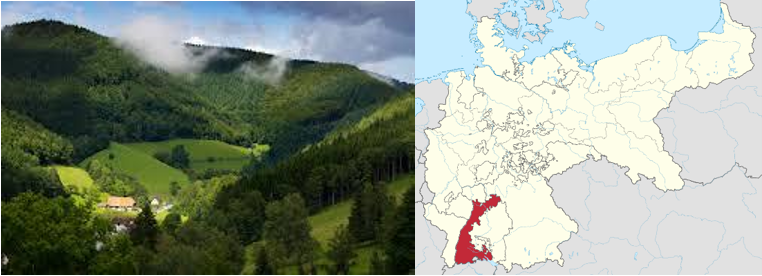
Andreas was also from Baden. He worked as a butcher at 325 5th Avenue in New York City. They lived in the crowded 17th Ward, where many families were immigrants from Germany or Ireland. Nearby families included a baker, a holder, a lager maker, and a Moroccan case maker who were all from Wurttemberg. Others were a porter from Ireland, a cabinet maker and his apprentice, and a lager beer saloon owner from France. Andreas’ personal estate was estimated at three hundred dollars.
This feisty 1858 New York Times article about springtime, which ends with, “Keep cool and don’t put on too much steam at once,” mentions the 5th Avenue butchers.
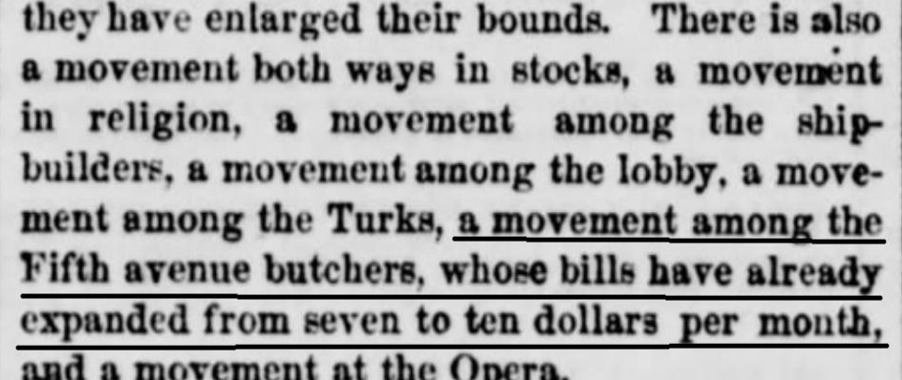
https://www.newspapers.com/article/new-york-daily-herald-description-of-nyc/118168681/
Butchers were highly esteemed, and it was a much-regulated profession during that time. According to the NYC Archives, there were many open markets around the city and butchers were located at each. They wore elaborate dress as a sign of their status.
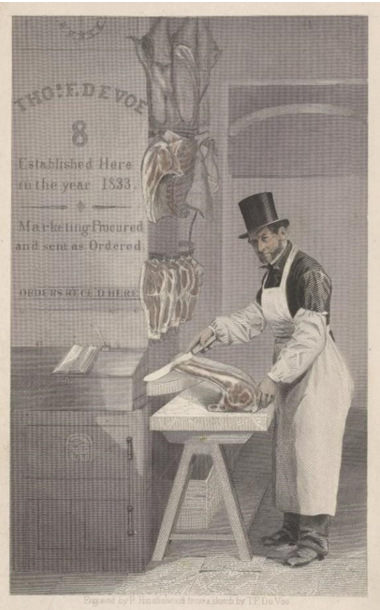
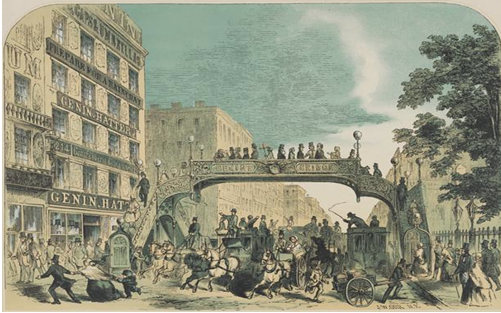
After their son John was born in September of 1861, the young family began preparations for a move from New York City to a small farming community west of the growing City of Cincinnati, Ohio. The reason for the move is not known for certain and it seems abrupt. This was during the years of the Civil War, which seems like an odd time to pick up roots and move, especially since Andreas had a successful butcher business. Perhaps there were extenuating circumstances that prompted their move. (See the end for The Murder Theory and The Criminal Immigrant Theory.) The most likely scenario was that Andreas moved to escape the stigma associated with a family member and his public demise.
Ohio
There was one known family with the surname Schacht living in Cincinnati proper around the time that Andreas moved to the area – William and Mary Schacht. However, Andreas did not settle near them in 1861. Instead, they settled quite a bit to the west of Cincinnati. Through the years, it never appeared that the families were associated.
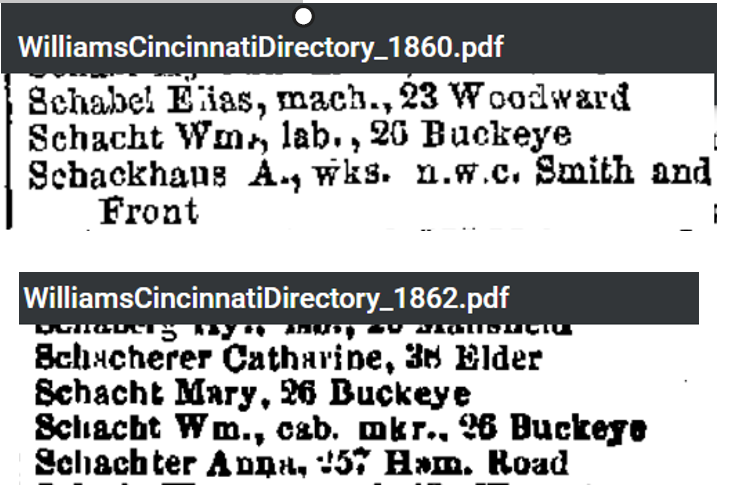
Andreas and his family settled in Bridgetown, Greene Township, Ohio, which was a very small settlement about 10 miles west of Cincinnati proper. Andreas was a farmer and had livestock with a good piece of land.
The record below is for Anthony Schacht, with wife, Martha, and son John and daughter Catherine. The dates, places of birth of parents and names, and dates of birth of children match. The names Anthony and Martha do not. Also, their son John was listed as having been born in Ohio, not New York. However, there is a burial record that lists Andrew Schacht. Soon after Andrew Schacht died, there were no more records of this family in the area and Eva, John, Kate, and Valentina showed up in Cincinnati for the first time. Other records consistently use their correct names.
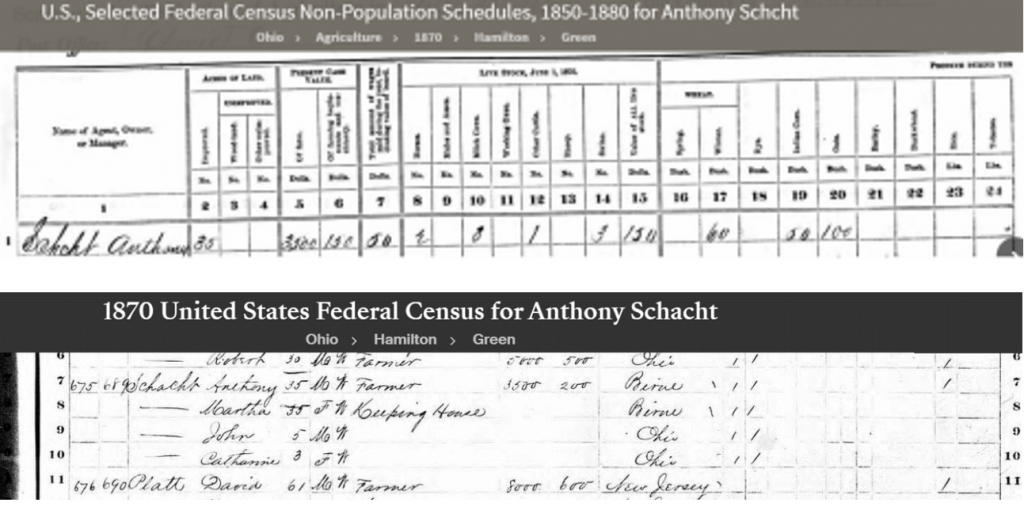

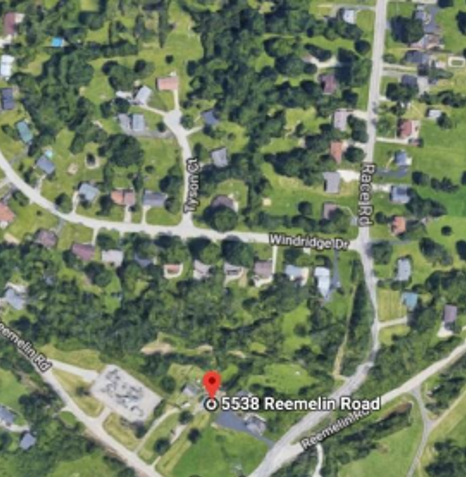
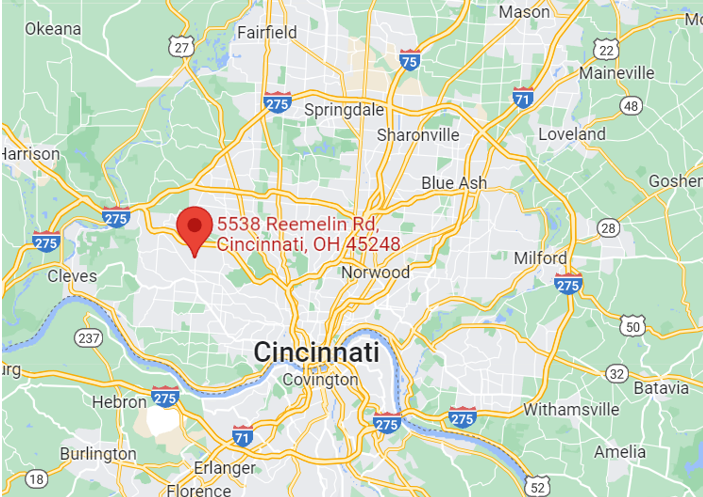
Their daughter Catherina Eva (Katie) was born in December of 1867. She was baptized at St. Aloysius Gonzaga on January 15, 1868. Her parents’ names are clearly listed as Eva Kaufhold [sic] and Andreas Schacht. Three years later, Valentina Regina was born in April of 1870. Her name is Latin and means ‘health and love.’
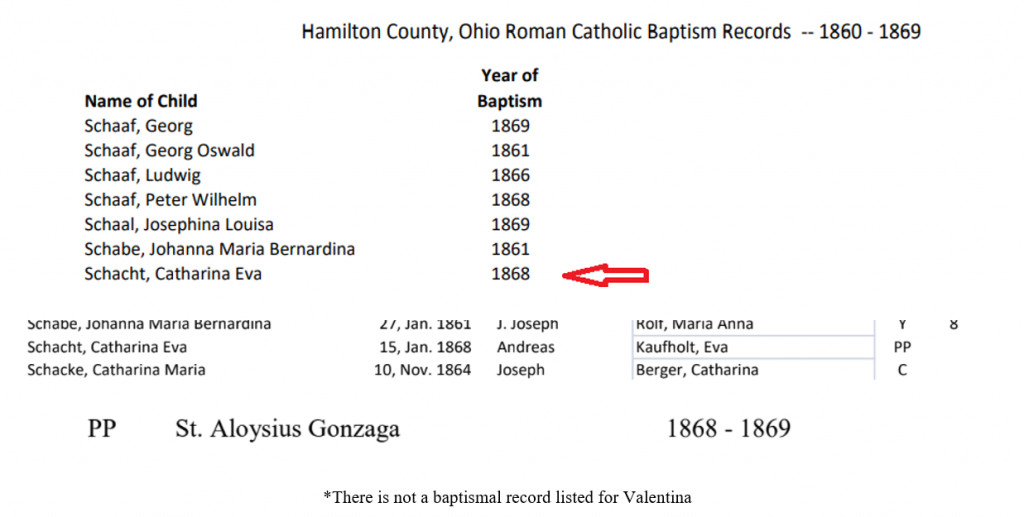


Valentina was not listed in the St. Aloysius Gonzaga baptismal records. Neither was she listed on the 1870 census, which was taken on July 26, 1870. She was born on April 18, 1870, so it is a mystery as to why she was not listed.
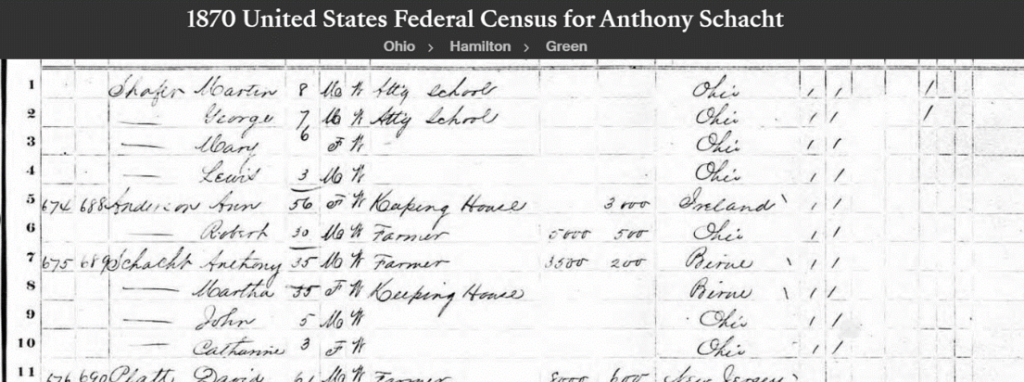
Andreas (Andrew) died a year and four months later, on October 25, 1871. The circumstances of his death are unknown. He is buried at St. Aloysius Gonzaga Church Cemetery in Bridgetown, Ohio, Section 5 Lot 210 Grave 7. He was only 36 years old.

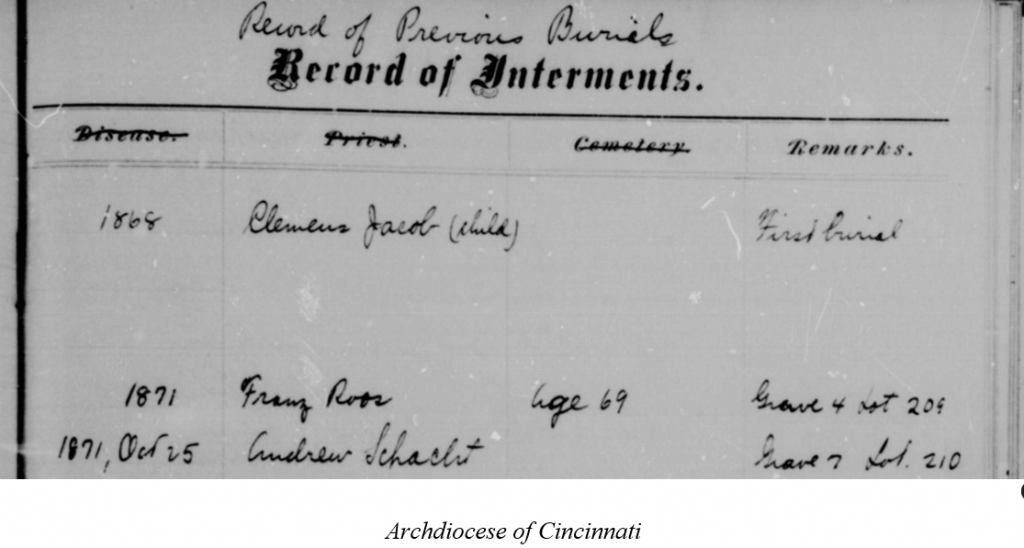
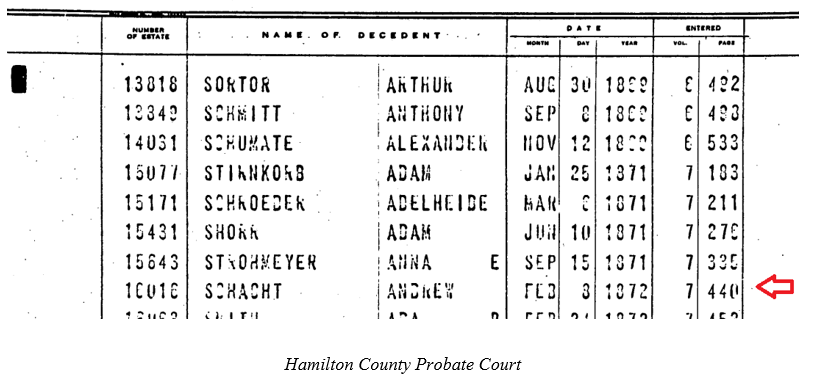

Five days after Andrew died, there was an entry for the assignment of estate sureties and by the end of April, there was a bond paid and a Resignation of Guardian filed. This could mean that Andreas (Andrew) was the guardian, not the father, of one of the children listed in his household. After death of the guardian, the guardianship was normally transferred to the surviving spouse. So, this is a clue that Valentina may have been the child of a relative, since there is no baptismal record for her, and she was not listed on the 1870 census. (The Hamilton County guardianship records are not indexed. So, a manual search of the handwritten indexes on page 0 of each volume was conducted and no other entry for this family was found.)
After her husband died, Eva and the children probably tried to maintain the farm for a few years. By 1877, though, they had moved to the city (Cincinnati) and Eva had a job as a confectioner.
The family moved very frequently during the years between 1878 and 1907 and Eva was listed as a widow, once as “widow of Andreas”, specifically. She worked at various jobs including as a laundress, a confectioner, and in a grocery. From 1879 to 1884, her son John’s job also changed frequently and ranged from huckster to laborer to wheel maker to machine hand.
A detailed search of the Williams Street Directory reveals that before Eva moved to the City Proper, after Andreas died, there were two men named John Schacht in Cincinnati. One was the son of William and Mary Schacht and his occupation was consistently listed as a bookbinder. This is the family mentioned before that does not seem to be connected. The other John had varied occupations from year to year. When Eva moved to town, her son, John Schacht also came.
Beginning in 1880, there were then three men with the name John Schacht listed in the Williams Directory. In the 1880, two men named John lived at the same address as Eva – John, a huckster and John H., a car painter. John, the huckster, was her son. The address was 26 Jones St. Determining who John H. was may help us find more about this family and why they moved to Ohio. He was listed in the directory only once at Eva’s address.
In 1880, Eva’s daughter Katie worked as a nurse, serving in the household of Maurice & Henrietta Doob (?) at 336 Richmond Street. She was 12 or 13 years of age.
The 1888 Williams Street Directory listed Eva and all of her children in one household, living at 1 Corwine, and it listed her deceased husband as Andreas. In 1890-91, The Williams Street Directory lists Eva, widow of Andrew, Valentina, and Katie at the same address – 38 Fifteenth Street. This is the evidence that ties this family together in one record.
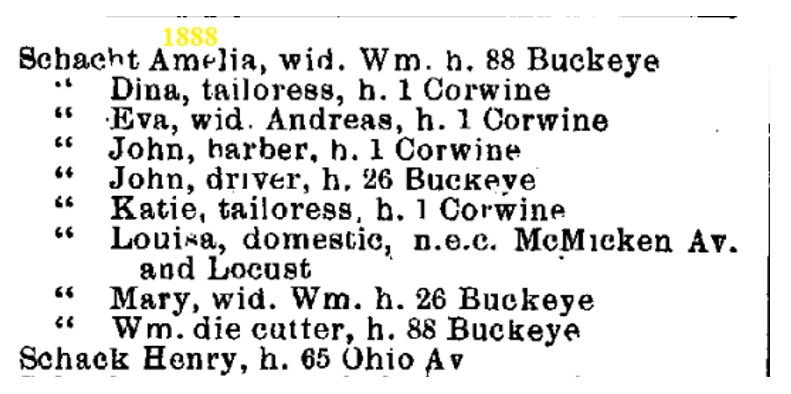
The Williams Street Directories were crucial in verifying information that led to the discoveries of subsequent documentation. Eva Schacht was listed as the widow of Andrew or Andreas in two different entries. (When this research began, it worked backward from the point of Valentina. This is the first evidence of Eva’s husband’s name, which then led to Andreas Schacht of NYC and later to Andrew Schacht of Green Township.) Her address was the same as John, Kate, and Valentina in various entries. The census reports only show Valentina in the household in 1880 when she is listed as “Dena.” This was a transcription error on the part of the census taker, as they probably called her “Tina.” The same type of transcription error occurred in the Williams Street Directory in 1888, which listed her name as “Dina.” (Valentina’s death certificate lists her father as “Unknown Schacht”, which is the original verification of her maiden name. The 1880 census record is very important to this research. It tells us that Valentina’s parents were born in Bavaria and that her brother, John, was born in New York. This is the evidence that Eva and her husband lived in New York after migrating and that they were there in the year 1861.) Valentina’s sister, Katie, was born in Ohio in 1867. This is evidence that they left New York for Ohio between 1861-1867. Eva’s maiden name was derived from Katie’s baptismal and marriage records.
Valentina’s maiden name was verified by her daughter’s marriage record. Missing for Valentina are: birth record, baptismal record, and 1870 census record. The only way we have tied Valentina as the child of Andreas and Eva Schacht are the Williams Street directories and the 1880 Census where her name was spelled incorrectly.
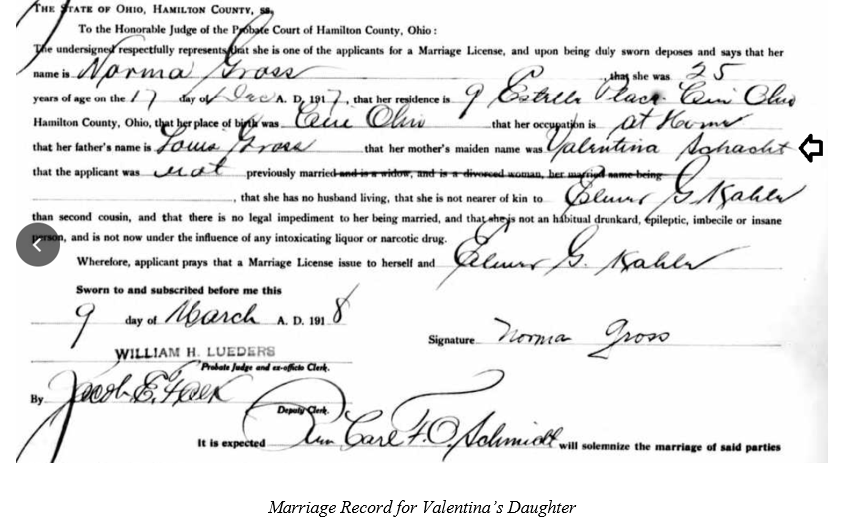
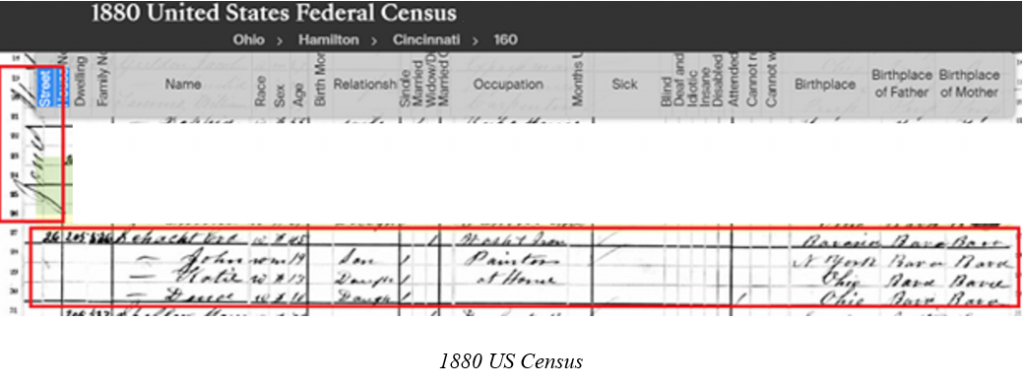
In February of both 1883 and 1884, there were terrible floods in Cincinnati. In 1884, the Ohio River peaked at 71.1 feet. As you can see from the following pictures and articles, many families were devastated. They lost their homes and belongings, and many had to be rescued from the roofs of their homes.
It is not known how Valentina and her family were directly affected by either of these floods, but they all survived. Valentina was about to turn twelve years old when the first flood hit.
Only a month after the 1884 flood subsided, there was a major riot in downtown Cincinnati. The angry mob burned the courthouse after hearing an unfavorable verdict of “manslaughter” in the case of a man who killed his boss to rob him of $285.
After her husband died, Eva and her children probably tried to maintain the farm for a few years. By 1877, though, they had moved to town and Eva had a job as a confectioner.
The family moved very frequently during the years between 1878 and 1907 and Eva was listed as a widow, once as “widow of Andreas”, specifically. She worked at various jobs including as a laundress, a confectioner, and in a grocery. From 1879 to 1884, John’s job also changed frequently and ranged from huckster to car painter to laborer to wheel maker to machine hand.
In 1880, Katie worked as a nurse, serving in the household of Maurice & Henrietta Doob (?) at 336 Richmond Street. She was 12 or 13 years of age.
In 1890-91, The Williams Street Directory lists Eva, widow of Andrew, Valentina, and Katie at the same address – 38 Fifteenth Street. This is the evidence that ties Valentina to Eva and this family. The census reports only show Valentina in the household, in 1880 when she is listed as “Dena.” This is perhaps a transcription error on the part of the census taker, as they probably called her “Tina.” (Valentina’s death certificate lists her father as “Unknown Schacht”, which is the verification of her maiden name.)
In February of both 1883 and 1884, there were terrible floods in Cincinnati. In 1884, the Ohio River peaked at 71.1 feet. As you can see from the following pictures and articles, many families were devastated. They lost their homes and belongings and many had to be rescued from the roofs of their homes.
It is not known how Valentina and her family were directly affected by either of these floods, but they all survived. She was about to turn twelve years old when the first flood hit.
Only a month after the 1884 flood subsided, there was a major riot in downtown Cincinnati. The angry mob burned the courthouse after hearing an unfavorable verdict of “manslaughter” in the case of a man who killed his boss in order to rob him of $285.
| From Historical Collections of Ohio, by Henry Howe 1888: “Cincinnati has never witnessed such violation of the law, defiance of authorities, and so much bloodshed as attended the great Hamilton County Courthouse riot on the night of March 28, 1884, and continuing for several days, there being open conflict between the militia and police on one side and an excitable, yet determined mob upon the other. The circumstances that led to this most unfortunate affair was the trial for murder of Wm. Berner, who killed his employer, Wm. Kirk. It was one of the most outrageous assaults upon society, and a dastardly, cold-blooded crime that unsteadied the nerves of the populace, causing excitement to run high, and incensed all law- abiding citizens when the case came to trial by the methods pursued by criminal lawyers, who sought to perjure witnesses, bribe juries, and resorted to open handed means to have their client acquitted against all principle of law or justice. There was a call at the great Music Hall on the evening of March 28, 1884, a mass meeting of citizens. Immediately after the meeting, as the masses were surging out upon Elm street, someone in the crowd shouted, ”Fall in! Let’s go to the jail!” and a great mob from the meeting proceeded directly to the county jail in the court-house on the Sycamore Street side, above Court Street. On the way the mob was increased by hundreds of others. Upon reaching the jail it was surrounded by a howling, angry crowd. A piece of joist was procured, and with it the basement doors, at the foot of the stone steps, were battered down. Bricks and stone were hurled by men in the street above at the windows. Clubs, huge pieces of timber, crowbars, and other weapons were quickly procured and passed down to the men who were at work upon the heavy outside entrance doors of the jail, and it at last yielded, the work being done speedily. The crowd then poured into the jail office, and there found other obstructions in the matter of stone walls and heavy iron grated doors. Morton L. Hawkins, the county sheriff, and his few deputies faced the mob upon their entrance between the outer and inside doors. They were powerless to stem the fierce human tide, and besides the sheriff had given orders to his officers not to use their weapons on the mob, believing that such proceeding would only make bad worse. The mob completely filled the interior of the jail, yelling and searching for the murderer they had come to hang. They filled the corridors, and a force of men succeeded in so forcing the iron grated door that it at last gave way, and the mob ran up the winding stone stairway to the cell rooms, peering into each cell and demanding of other prisoners the where-abouts of the murderer whom they sought. While this was going on within a squad of fifteen policemen arrived on the scene and began clearing the jail, meeting with but little success, as they were set upon by the mob and hurled to one side as though they were not there. At 9.55 P.M. the fire-bells sounded the riot alarm. This brought people to the scene from all sections of the city, and they turned in with the mob, the greater majority being in sympathy. It called the police from their posts of duty and the various stations; and through good management they were formed above and below the jail in two sections, and, headed by the patrol wagons, advanced upon the crowds assembled on Sycamore Street, in proximity to the jail. The crowd outside was estimated to be between nine and ten thousand. The patrol and police advancing in two solid columns caused a stampede, the rioters escaping through side streets. Ringleaders and some of those who had been active inside the jail were taken in the patrol wagons to the station houses. The patrols were permitted to leave amid much jeering and denunciatory language, and after their passage the gap was closed up and another onslaught made upon the jail; the rioters in the meantime having armed themselves with axes, stones and bricks. Upon their being repulsed, however, a great crowd rushed over toward Main Street and down town. Simultaneous attacks were made upon the entrances of several gun stores, and the places completely gutted of firearms, powder, cartridges and other ammunition. In the meantime others of the mob had fired the jail and the courthouse, in a score of places, coal oil and powder being liberally used, and neighboring stores and groceries being sacked for the purpose. Affairs were assuming a serious and critical aspect. The light of the fires illuminated the whole city, causing hundreds of other citizens, upon the hilltops and in the suburbs, to hasten to the scene. Immediately after the sentence had been pronounced that afternoon the murderer Berner had been hurried to Columbus, going in a buggy to Linwood, where the train was taken. He was in custody of Dominick Devots, a watchman or deputy sheriff, and through the latter’s negligence the prisoner managed to escape from him while the train was at Loveland. All these things the rioters of course were ignorant of. They had been told by Sheriff Hawkins that the prisoner was not in jail upon the first attack, but this was looked upon as a subterfuge to cause them to cease their violence. The fires around the jail and court-house had been put out, and towards early morning the mob, almost worn out with their labors, thinned out, but hundreds remained about the scene throughout the night, and as the hours approached the working hour their numbers were increased. All day long Saturday the militia and police were on duty, and the courthouse and jail were surrounded by tired-out but determined men, and thousands of others drawn there by the excitement of the occasion. There were no attempts at attack made during the day, but Saturday night for several blocks above and below to the east and the west of the jail and court-house the streets were choked by rioters who had greatly increased their strength, and another attack on the jail was made. This proved to be the most serious attack of all, and the most disastrous. Admission was gained to the courthouse. The militia in the streets were held in a hollow square formed under the masterful leadership of some of their number. Once inside the courthouse, the work of demolition began. The whole magnificent stone building seemed to become ignited at once. The whole place was gutted and the valuable records of three-quarters of a century’s accumulation were destroyed. The building burned to the ground. The governor of the State had called out the militia of the State, and they were arriving by every train. Their appearance upon the scene seemed to more aggravate and incense the mob, and being fired upon a bloody riot began in the streets, men being mowed down like grass under the keen sweep of a scythe. Captain John J. Desmond, of the militia, was shot and killed inside the burning courthouse, while leading an attack on the mob. Many prominent citizens received wounds from stray shots of the militia. Windows, doors and even walls of houses in the vicinity of the riot to this day bear evidence of that time of terror and bloodshed. United States Secretary of War Lincoln ordered to the scene the United States troops, and their appearance seemed to have the desired effect, as the rioters gradually dispersed. The result was, however, that 45 persons were killed and 125 wounded. Berner, the cause of all this terrible loss and destruction to life and property, was recaptured late on Saturday afternoon in an out-of-the-way house in the woods on a hillside near Loveland. When captured by Cincinnati detectives, aided by the marshal of Loveland, he was coolly enjoying a game of cards, and was unaware of the riot and the attack upon the jail. He was taken to Columbus and lodged in the State penitentiary under the sentence that had been passed upon him on the 26th day of March of confinement for twenty years.” |
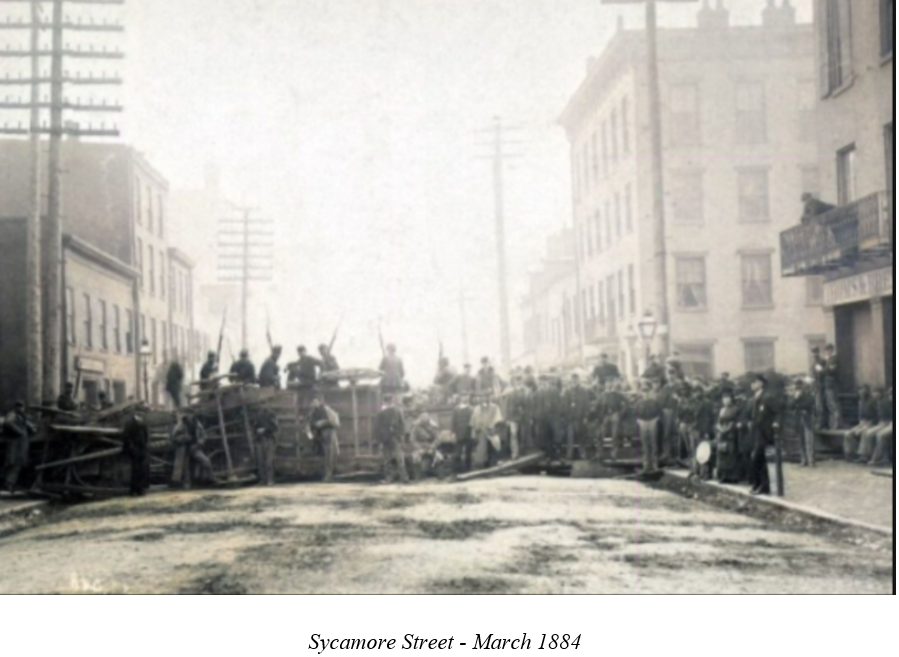
By 1890, Valentina and her family had relocated to 38 Fifteenth Street in Over the Rhine, between Vine and Elm Streets. John had moved out to be on his own, but Katie and Valentina still lived with their mother. The girls supported themselves and Eva by working as tailoresses and were listed in the Williams Street Directory.
In 1890 there was there was a John Schacht listed at 26 Buckeye. This address was associated with a man named William Schacht and a baby named Katie Schacht, who both died there fourteen years prior, in the year 1876. Since the 1888 Williams Directory lists John Schacht with his mother, Eva, at 1 Corwine and simultaneously listed a John Schacht at 26 Buckeye that year, we know there were two men named John Schacht and the man listed at 26 Buckeye was not Eva’s son. John Schacht that lived at 26 Buckeye was the son of William and Mary. He was a bookbinder and he died on January 5, 1891 and is buried at Vine Street Hill Cemetery. His middle initial was “P.” When Andreas, Eva, and baby John first moved to Ohio, this was the only other Schacht family in the area. There does not seem to be a relationship.
Eva’s son John had various occupations, the last being a barber. He married and had five children. His eldest two were named after his parents.
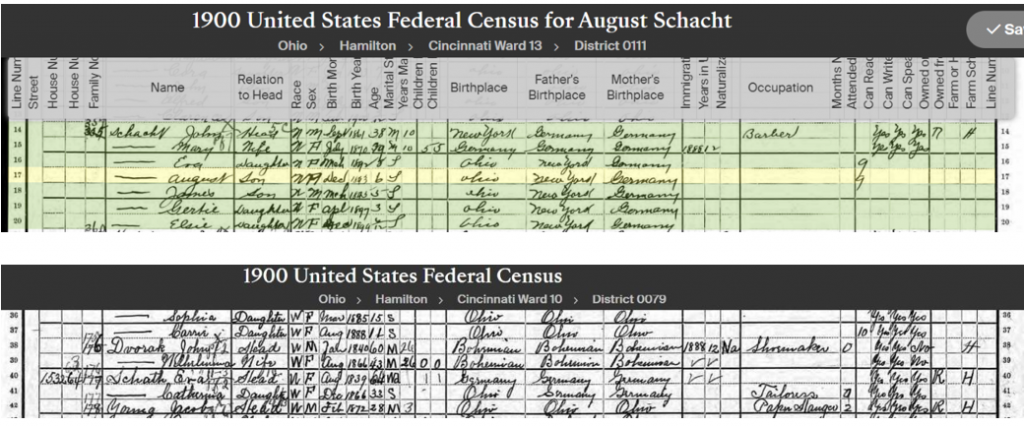
The 1900 Census has some misinformation. The last name for Eva was spelled incorrectly, and the date of birth says Aug 1839. (However, her age was listed as 64 and then crossed out and changed to 60.) It also says she had one child and one child still living. There is a check mark under migrated 1888 from previous entry of another family. These discrepancies would normally make one think this a record for another person, entirely. However, the address 1532 Bremen St. matches the Williams Directory for 1900 for Eva Schacht, which states Eva was the widow of Andrew. It also matches the address on a marriage record for the same year, 1900, for Katherine Schacht that lists Eva Kaufort as the mother of the bride, Katie Schacht. (Though it lists her father as John Schacht, which contradicts the baptismal record.)
Curiously, there is an entry in the 1900 Williams Directory at that address for Lizzie Schacht. This is a new name unless Katie’s middle name was Elizabeth. However, she had gone by the name Katie very consistently. There is no census record for someone named Lizzie.
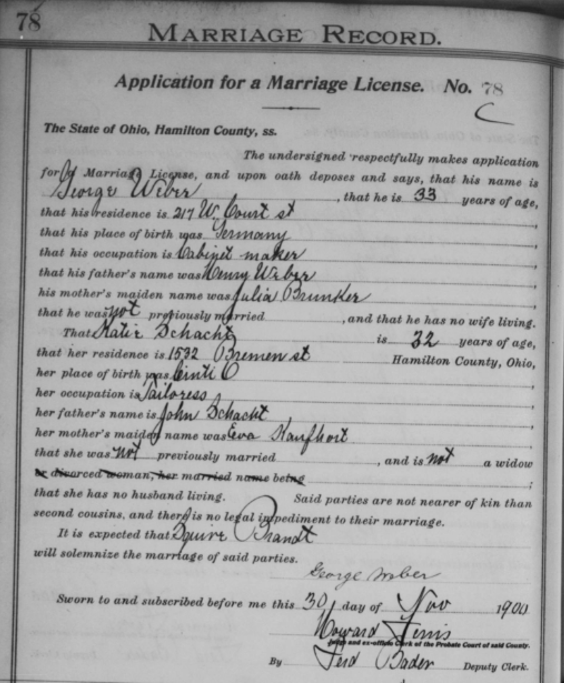
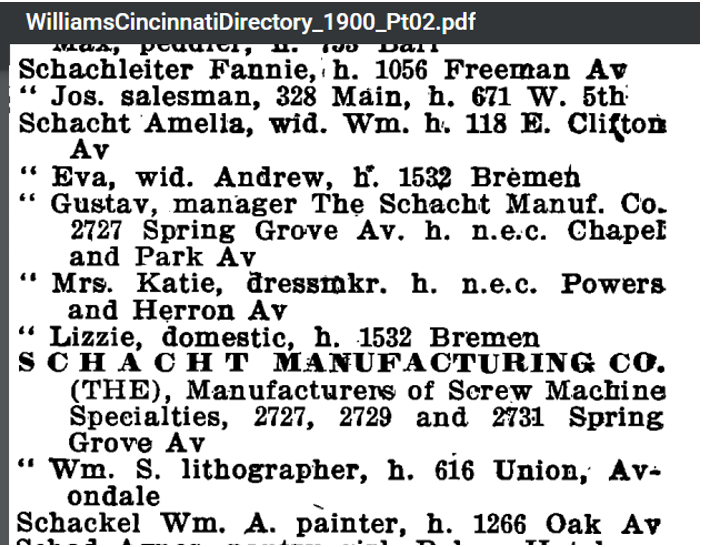
Valentina married Louis Gross in 1890. They went on to have nine children. Their third child was named for Valentina’s mother, Eva, but she died of convulsions at two days old on 12/21/1897.
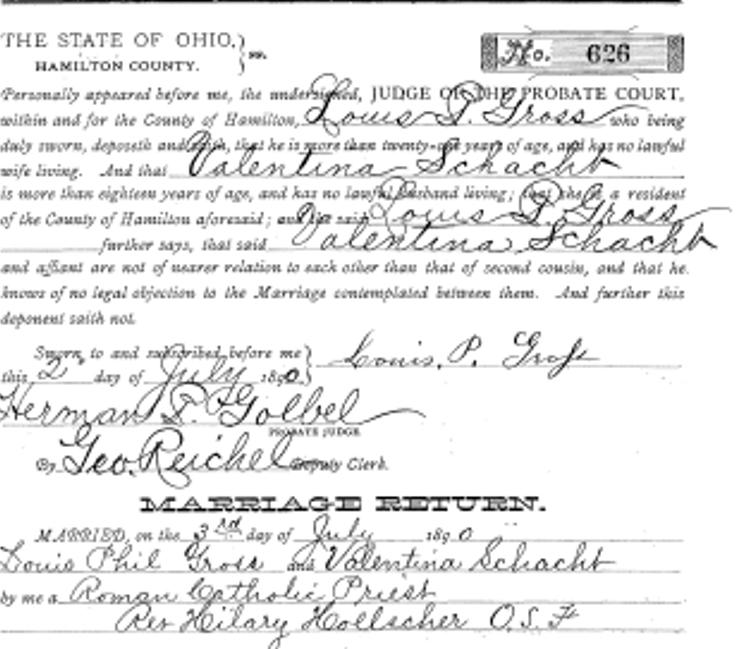
Eva died on August 30, 1914 and is buried at St. Aloysius Gonzaga in Bridgetown, Ohio with her husband.
She had sixteen grandchildren in all.

Questions and Theories
Questions
Who was John H. Schacht who appeared in Eva’s Household in 1880? Was this Johann Friedrich Schacht, the murderer from New York and the “H” was an error in the directory? Was this the true father of Valentina? Why was he not listed on the 1880 census or ever again in the Williams Directory? Why was Katie’s father listed as “John Schacht” on her marriage record? Why did Valentina not have a baptismal record or census record for 1870? Why was there a Resignation of Guardianship for Andrew Schacht five days after he died? Why was Eva listed as the mother of only one child on the 1900 census? We know for a fact that John and Katie were her children according to the 1860 Census and Katie’s baptismal record.
Fleeing the Murder Stigma Theory
Why did Andreas and his family move to Green Township Ohio in the middle of the Civil War and while he was a successful butcher in NYC?
In 1860 New York, there was a high-profile murder trial for a young man named Frederick Schacht, also a butcher or worked for a butcher, who killed a man – Michael Cavanagh – with a meat cleaver.
The man that Frederick killed had been tormenting him by coming to the butcher shop and harassing him. On the day of the incident, Michael Cavanagh had brought a gang of other young men and they were teasing Frederick about a girl in the neighborhood. Frederick became angry and hit Michael. Someone in the group struck back and then Frederick ran into the butcher shop and grabbed a meat cleaver, then used it to hit Michael over the head. His skull was cracked and Michael succumbed to his injuries the following day. Frederick was arrested and a long trial ensued.
This incident occurred in front of Frederick’s place of employment on Pearl St, the meat cleaver having been taken from the shop, which was located across from City Hall Place. This was just near the “slum” area known as “5 Points,” which was notorious for mayhem. In fact, the famous scene in the movie The Gangs of New York took place in this same spot, and actually included a butcher wearing a top hat.
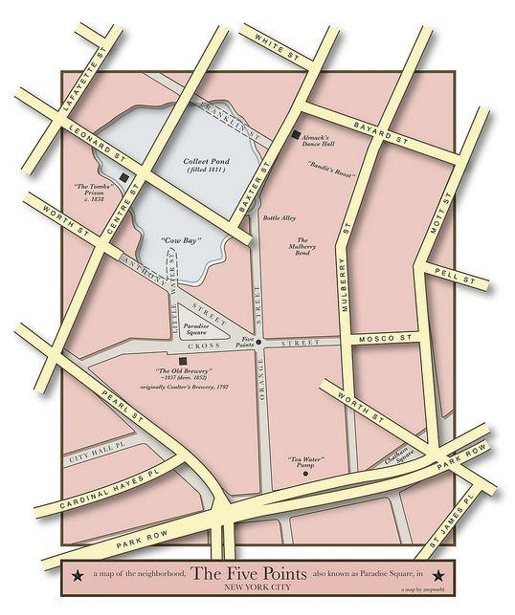
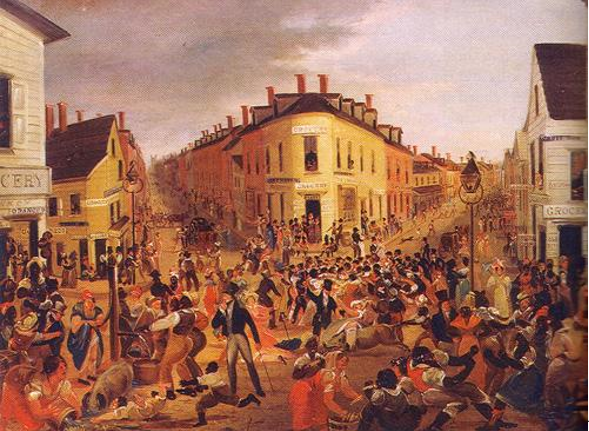
Andreas’ butcher shop was located at 325 5th Avenue, which was not in the same area, so he was a “5th Street Butcher.” However, the fact that both men had the same last name and profession could mean that they were in some way related and a scandal of that proportion could have been the cause for Andreas to move to Ohio and separate himself.
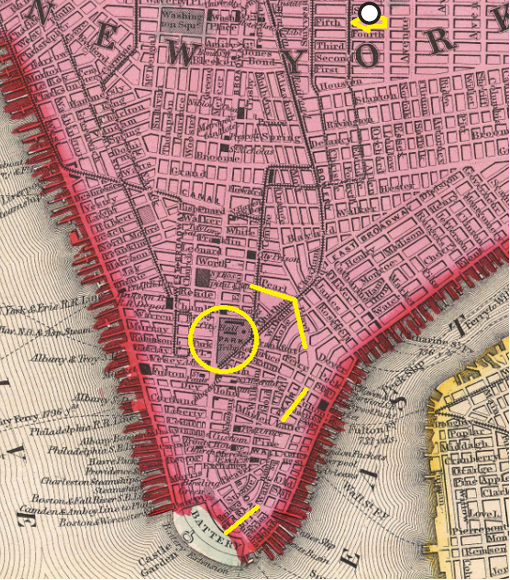
Frederick Schacht was convicted of manslaughter. He served four years in Sing Sing Penitentiary, entering December 20, 1860 and being released September 26, 1864.
Was the Murderer this Criminal?
There is an immigration record for Johann Friedrich Schacht from Bayern (Bavaria). He emigrated in 1856 and his age was 21, which puts his date of birth at 1835. There is a note that says “wanted.” The police record regarding “wanted” indicates that his actual date of birth was 1832.
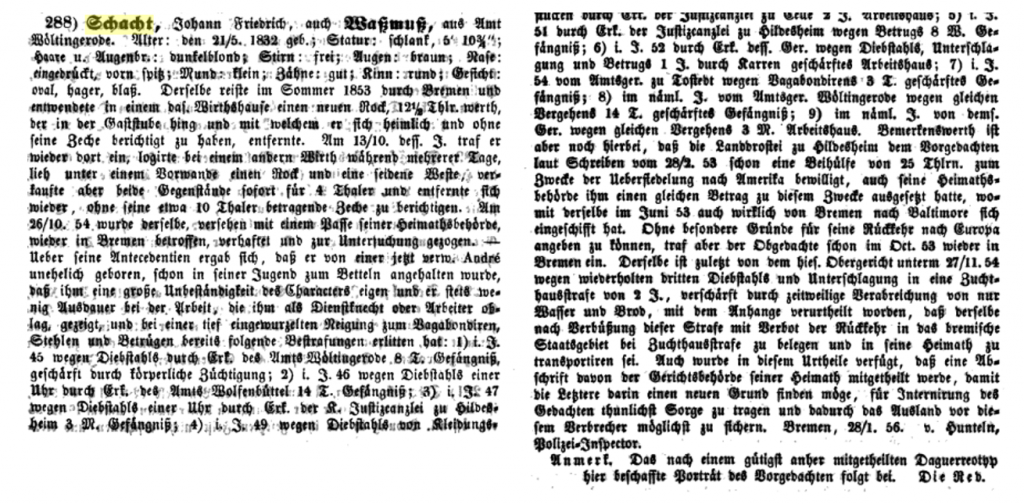
Note. The portrait of the forethought obtained here after a daguerreotype, which has been treated kindly follows. The Red [ Action ]
A basic synopsis of the document tells us that Johan Friedrich Schacht was from Wöltingerode. He was born out of wedlock and therefore was in the position to keep poor company, had a terrible work ethic, would often steal or lie, and spent time in the workhouse. He was granted the right to emigrate based solely on the fact that he might take the chance to turn himself around. More research on him indicates that he committed various property crimes followed by ever more serious sentences and stays in prison. Johann Friedrich Schacht used the alias surname of Waßmuß. He born on May 21, 1832, out of wedlock to a woman with the widowed surname of André. His physical features were described in detail and his photograph was originally enclosed in the police newsletter, but it was not found. He emigrated by ship in June 1853 from Bremen to Baltimore but returned to Bremen in October 1853. It was recommended to the judicial authority of his native country to incarcerate him again “to thereby safeguard the countries abroad from this criminal as much as possible”.
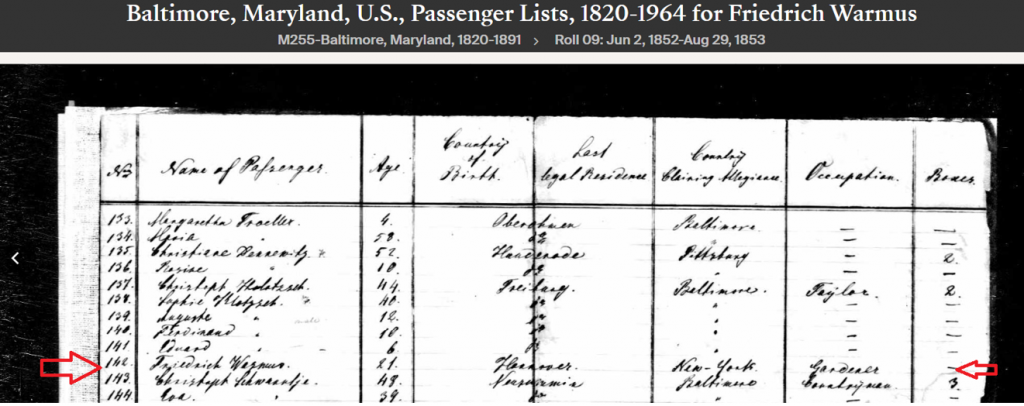
Likely the criminal Johann Friedrich Schacht stayed in Bremen without returning to the United States. However, is it possible that he did migrate again and was the meat clever murderer?
Just the facts
- The murder conviction and sentencing for Friedrich Schacht in NYC was in December of 1860. He was 23 and therefore born in 1837. Andreas was born in 1835 and so was Johann Friedrich Schacht, the criminal. (The police/emigration record for Johann Friedrich Schacht indicates that his dob was May 21, 1832, but the immigration record indicates 1835.)
- The butcher shop where Andreas worked was not in the same location as the butcher shop where Johan Friedrich worked.
- Andreas’ first-born child, John Schacht, was born in NYC in September 1861, exactly 9 months from when Johann Frederick entered Sing Sing.
- After 1861, there was no listing in the street directory of NYC for Andreas Schacht.
- There is a six-year gap between the births of John and Katie Schacht.
- Katie’s marriage record says her father was “John Schacht,” not Andreas. (Sometimes the eldest living brother was listed if the father was deceased.)
- In considering that Andreas was actually Johann Friedrick Schacht and that he changed his name – Andreas Schacht had a personal estate worth $300 in 1860. By 1870, his property was worth $3500 and personal estate $200. This is not consistent with someone who worked near “5 Points.”
- Johann Frederick often whistled at the girls walking past the butcher shop and the young men that came to harass him were doing so because of a girl he liked. Andreas was married.
- There is a death record for Johann Friedrich Schacht in Cincinnati that would contradict Andreas as being the same person, however it could indicate that there were two men, with the same surname and occupation, who had dates of birth within a few years, who migrated from NYC to the Cincinnati area. Perhaps this is the man that lived in Eva’s household in 1880 and the “H” was an error in the directory.
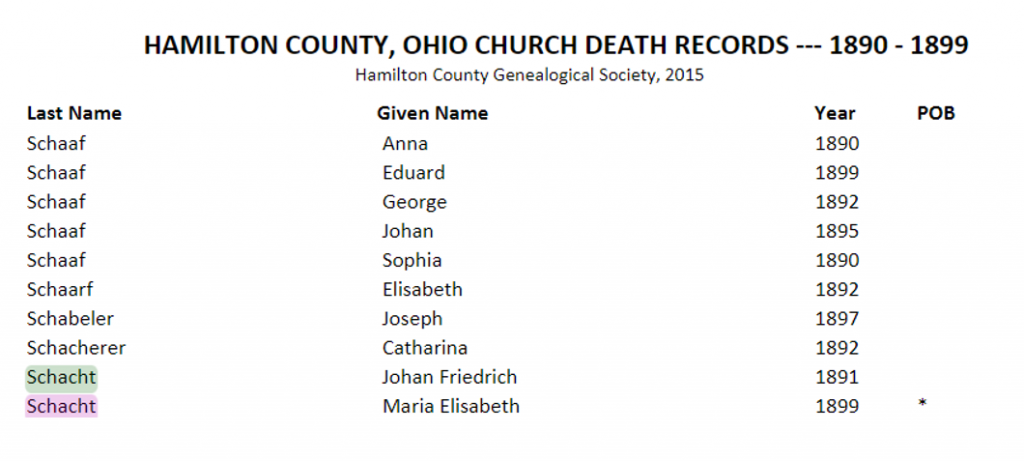
Conclusion
One theory is that Johann Friedrich Schacht migrated from Bavaria in 1856. He lived in NYC and worked as a butcher. He was convicted of murder but married/fathered a child (John) before serving time. He changed his name superficially before entering prison, though still went by his correct name in prison. He was released and then he and his family moved to Greene Township, Ohio under his assumed name.
Andreas was listed in the 1860-61 City Directory as a butcher in NYC. That record was likely compiled by May or June of 1860, which was six months before Frederick entered Sing Sing. This would mean a name change took place before the prison sentence; however, the prison records do list the name Friedrich. Andreas was never listed in New York again after that year. Friedrich was not listed after the prison release date, either. This reinforces the idea that he left NYC and they were perhaps one and the same person.
However, the migration record information and manslaughter conviction do not seem to match with a person who has earned enough money and the means to travel to a small farming community in Ohio to start a new life, in the middle of the Civil War, no less. Also, the location of the murder does not match the location of Andrew’s butcher shop, nor was Johann Friedrich referred to as “a butcher,” but rather as a butcher shop employee.
The most likely theory is that Andreas and Frederick were related, but not the same person. Andreas was more successful and he left NYC to move to Ohio after the manslaughter conviction of Frederick, who left NYC after his release from Sing Sing, to parts unknown, but perhaps stopping in Cincinnati from time-to-time and that the Johann Friedrich Schacht aka Wasmus, was in no way related to either of these men.
There is also the open question about the Resignation of Guardianship directly following Andreas’ death. That strongly indicates that Valentina was the child of a relative. More research to find John H. Schacht, the car painter who lived with them in 1880, is needed.
Another thing to consider is the Civil War. Was Andreas conscripted? Did he receive land in Ohio as payment? This might explain the gap between the children’s birth dates. More research of the military files is needed.

